Non polar hydrophobic - Study guides, Class notes & Summaries
Looking for the best study guides, study notes and summaries about Non polar hydrophobic? On this page you'll find 1686 study documents about Non polar hydrophobic.
Page 4 out of 1.686 results
Sort by
![WGU C785 BIOCHEMISTRY EXAM [QUESTIONS AND ANSWERS] [GRADEDC A 2023/2024]](/docpics/3637025/652e3d35976bd_3637025_121_171.jpeg)
-
WGU C785 BIOCHEMISTRY EXAM [QUESTIONS AND ANSWERS] [GRADEDC A 2023/2024]
- Exam (elaborations) • 31 pages • 2023
-
- $14.49
- + learn more
WGU C785 BIOCHEMISTRY EXAM [QUESTIONS AND ANSWERS] [GRADEDC A 2023/2024] What is the basic structure of an amino acid? What do they look like? - CORRECT ANSWER amino group (NH2 or NH3), carboxyl group (COO or COOH), alpha carbon (C), and variable group How do you identify the 3 different types of side chains: non-polar/hydrophobic, polar, and charged? - CORRECT ANSWER Non-polar/hydrophobic - end with CH or "can't have" water. Polar - end with OH, SH, or NH. Charged - end with a ...
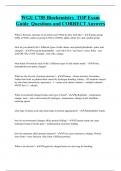
-
WGU C785 Biochemistry TOP Exam Guide Questions and CORRECT Answers
- Exam (elaborations) • 23 pages • 2024
-
- $8.99
- + learn more
What is the basic structure of an amino acid? What do they look like? - amino group (NH2 or NH3), carboxyl group (COO or COOH), alpha carbon (C), and variable group How do you identify the 3 different types of side chains: non-polar/hydrophobic, polar, and charged? - Non-polar/hydrophobic - end with CH or "can't have" water. Polar - end with OH, SH, or NH. Charged - end with a charge what kinds of bonds do each of the 3 different types of side chains make? - ionic, hydrophobic/non-p...
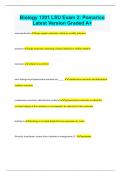
-
Biology 1201 LSU Exam 2: Pomarico Latest Version Graded A+
- Exam (elaborations) • 20 pages • 2024
- Available in package deal
-
- $9.99
- + learn more
Biology 1201 LSU Exam 2: Pomarico Latest Version Graded A+ macromolecules large organic molecules which are usually polymers polymers large molecules consisting of many identical or similar subunits monomer subunit of a polymer most biological polymerization reactions are_____ condensation reactions aka dehydration synthesis reactions condensation reactions (dehydration synthesis) polymerization reactions in which the covalent linkage of the monomers is accompanies by removal...
![WGU C785 EXAM [QUESTIONS AND ANSWERS GRADED A] [LATEST VERSION 2023/2024] What is the basic structure of an amino acid? What do they look like? - CORRECT ANSWER amino group (NH2 or NH3), carboxyl group (COO or COOH), alpha carbon (C), and variable gro](/docpics/3636910/652e3a22a1b08_3636910_121_171.jpeg)
-
WGU C785 EXAM [QUESTIONS AND ANSWERS GRADED A] [LATEST VERSION 2023/2024] What is the basic structure of an amino acid? What do they look like? - CORRECT ANSWER amino group (NH2 or NH3), carboxyl group (COO or COOH), alpha carbon (C), and variable gro
- Exam (elaborations) • 31 pages • 2023
- Available in package deal
-
- $13.49
- + learn more
WGU C785 EXAM [QUESTIONS AND ANSWERS GRADED A] [LATEST VERSION 2023/2024] What is the basic structure of an amino acid? What do they look like? - CORRECT ANSWER amino group (NH2 or NH3), carboxyl group (COO or COOH), alpha carbon (C), and variable group How do you identify the 3 different types of side chains: non-polar/hydrophobic, polar, and charged? - CORRECT ANSWER Non-polar/hydrophobic - end with CH or "can't have" water. Polar - end with OH, SH, or NH. Charged - end with a...

-
Biochemistry WGU OA 2022 Questions With Answers
- Exam (elaborations) • 19 pages • 2022
-
- $11.49
- 3x sold
- + learn more
Biochemistry WGU OA 2022 Questions With Answers. Amino Acid backbone consists of Ans - 1. amino group 2. carboxyl group 3. alpha carbon 4. R group Amino group: looks likes/consists of Ans - NH3+ Carboxyl group looks like/consists of Ans - cooAlpha carbon looks like/consists of Ans - CH The three Amino acid categories Ans - 1. hydrophobic (nonpolar) 2. polar 3. charged Hydrophobic Amino Acids Ans - non polar afraid of h20 usually in the middle/core of the protein contains H + C... C-C...
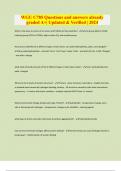
-
WGU C785 Questions and answers already graded A+| Updated & Verified | 2024
- Exam (elaborations) • 30 pages • 2024
- Available in package deal
-
- $13.48
- + learn more
What is the basic structure of an amino acid? What do they look like? - amino group (NH2 or NH3), carboxyl group (COO or COOH), alpha carbon (C), and variable group How do you identify the 3 different types of side chains: non-polar/hydrophobic, polar, and charged? - Non-polar/hydrophobic - end with CH or "can't have" water. Polar - end with OH, SH, or NH. Charged - end with a charge what kinds of bonds do each of the 3 different types of side chains make? - ionic, hydrophobic/non- pola...
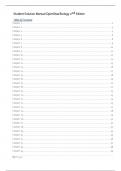
-
Testbank for Biology 2nd Edition from OpenStax College
- Exam (elaborations) • 57 pages • 2023
-
- $17.99
- 5x sold
- + learn more
Testbank for Biology 2nd Edition from OpenStax CollegeChapter 1 1 Figure 1.6 1: C; 2: F; 3: A; 4: B; 5: D; 6: E. The original hypothesis is incorrect, as the coffeemaker works when plugged into the outlet. Alternative hypotheses include that the toaster might be broken or that the toaster wasn't turned on. 3 Figure 1.16 Communities exist within populations which exist within ecosystems. 4 B 6 D 8 C 10 C 12 B 14 D 16 Answers will vary, but should apply the steps of the scientific method. One pos...
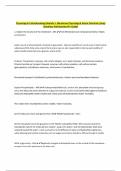
-
Physiology & Pathophysiology Module 1- Membrane Physiology & Action Potentials (Long) Questions And Answers (A+ Grade)
- Exam (elaborations) • 12 pages • 2024
-
- $14.49
- + learn more
Physiology & Pathophysiology Module 1- Membrane Physiology & Action Potentials (Long) Questions And Answers (A+ Grade) 1. Explain the structure of the membrane - ANS-Cell Membranes are composed primarily of lipids and proteins. Lipids consist of phospholipids, cholesterol, glycolipids - high permeability of membranes to lipid soluble substances (CO2, fatty acids, steroid hormones). Lips are also responsible to the low permeability of water-soluble molecules (ions, glucose, amino acid...

-
BIOLOGY EXAM 1 Duquesne University Questions And Answers With Verified Solutions
- Exam (elaborations) • 16 pages • 2024
- Available in package deal
-
- $7.99
- + learn more
The Scientific Method - A logical, systematic approach to the solution of a scientific problem. What is science? - The systematic approach to answering questions; step by step process that is logical and rational by collecting data thru experimentation steps of scientific method - 1. observation 2. question 3. hypothesis (that is testable) 4. test/experiment 5. conclusion conclusion of scientific method - accept hypothesis OR reject hypothesis and make a new hypothesis 2 groups of an e...
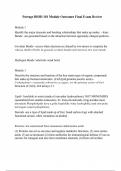
-
Portage BIOD 101 Module Outcomes Final Exam Review
- Exam (elaborations) • 37 pages • 2024
-
- $13.00
- + learn more
Module 1 Identify the major elements and bonding relationships that make up matter. - Ionic Bonds= are generated based on the attraction between oppositely charged particles. Covalent Bonds= occurs when electrons are shared by two atoms to complete the valence shells of both. In general, covalent bonds exist between two non-metals. Hydrogen Bonds=relatively weak bond Module 1 Describe the structure and function of the four main types of organic compounds that make up biomacromolecules. (Car...

How did he do that? By selling his study resources on Stuvia. Try it yourself! Discover all about earning on Stuvia


